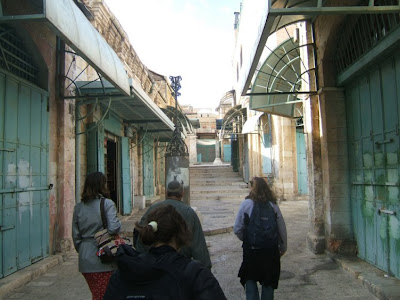 A map of the old city at present
A map of the old city at presentThe Old City
Rebuilding of the old city walls of Jerusalem in 1540, Turkish sultan Suleiman the Great turned the ancient city of Jerusalem into an island of life in the desert. For the first time in centuries, the Bedouin raiders who made settled life in the empty expanses of the Land of Israel unlivable could be kept at bay. Under lock and key at night, Jerusalem’s streets were quiet and safe. The city had already hosted congregation of Jewish stalwarts over the years, including such rabbinic greats as Rabbi Nachman ben Maimon (the Ramban,) as well as several synagogues, but now the community began to blossom. Over the next several hundred years, the community survived the famines, wars, and occasional sectarian violence, and by 1840 a majority (19,000) of the city’s 35,000 residents were Jewish.
Muslim Quarter, circa 1930's
Life was not without its hardship. Poverty was rampant, and life under the Islamic Apartheid system meant constant danger without legal recourse. Non-Islamic religions were permitted to exist, but only when it was clear who was in charge. Open sewers drained into cesspools built immediately adjascent to the Church of the Sephelcure, holy to Christians, and the Western Wall, Judaism’s holiest site, was used as a garbage dump and public urinal.
 The Dome of the Rock, circa 1930's
The Dome of the Rock, circa 1930's
But the “coexistence,” such as it was, was to be torn apart, along with the rest of the land, with the rise of the Jewish independence movement. Haj Amin Al Husseini, Grand Mufti (Muslim spiritual leader,) viewed the rise of Zionism as a threat his dreams of a united Syria including modern day Syria, Israel, Jordan, and Lebanon (the concept of Arab Palestine not yet existent.)

Haj Amin Al-Husseini, the Grand Mufti of Jerusalem
Fearing increased Jewish immigration, Husseini doctored tourist postcards of the Dome of the Rock to look as if it had been set ablaze, and then spread the photographs with a rumor that the Jews had started the fire. In the resulting riots, hundreds were killed, both in Jerusalem and across the countryside as enraged mobs pillaged and destroyed the Jewish quarter of Judaism’s holiest city, Jerusalem, and second holiest city, Hebron. After waves of riots, continuing year after year, the Jewish community within the walled city of Jerusalem had been completely expelled by 1948.

A meeting of the minds: Husseini with Hitler
Husseini visits Heinrich Himmler at Auschwitz
As a condition of the newly independent Israel’s armistice agreement with Jordan, Jews were to be allowed access to the Western Wall while the Kingdom of Jordan would maintain actual sovereignty. Of course, the terms were not honored, and Jordanian soldiers stood on the old city walls, shooting any Jew who drifted too close, and often taking pot shots into private houses in the Valley of Hinnom below.
The situation persisted for 19 years. In 1967, with the recapture of Jerusalem in the Six Day War, Israel found a section of the Jewish quarter of the old city still empty and in rubble, as the Jewish Quarter of Hebron is to this day.
The state initiated a massive rebuilding project, lasting 15 years, and eventually much of the Jewish Quarter was restored to its original beauty.

Entrance to the Cardo, in the Jewish Quarter. Because the Jewish Quarter was so recently rebuilt, much of the stonework and masonry appears cleaner and newer than the rest of the city.
Much as the Jews of Eastern Europe who survived the holocaust returned to their homes only to find Polish families living in them, so too thousands of those whose homes were not in the areas dynamited by the Jordanian Legion found that their old homes now had “tenants,” families who had moved in after the riots of 1967. The Israeli government, eager to demonstrate a non-belligerent policy of ruling the newly unified city, granted these tenants “squatters rights” and did not permit their eviction.

Walking through the Cardo. Nice stuff at tourist prices.
 An archway leading from the Armenian to the Christian Quarter
An archway leading from the Armenian to the Christian Quarter
Walking through the Christian Quarter. The closed shops are victims of the Second Intifada, which permanently destroyed much of Jerusalem's tourist industry.
And that’s where Ateret Cohaim comes in. To be continued…
No comments:
Post a Comment